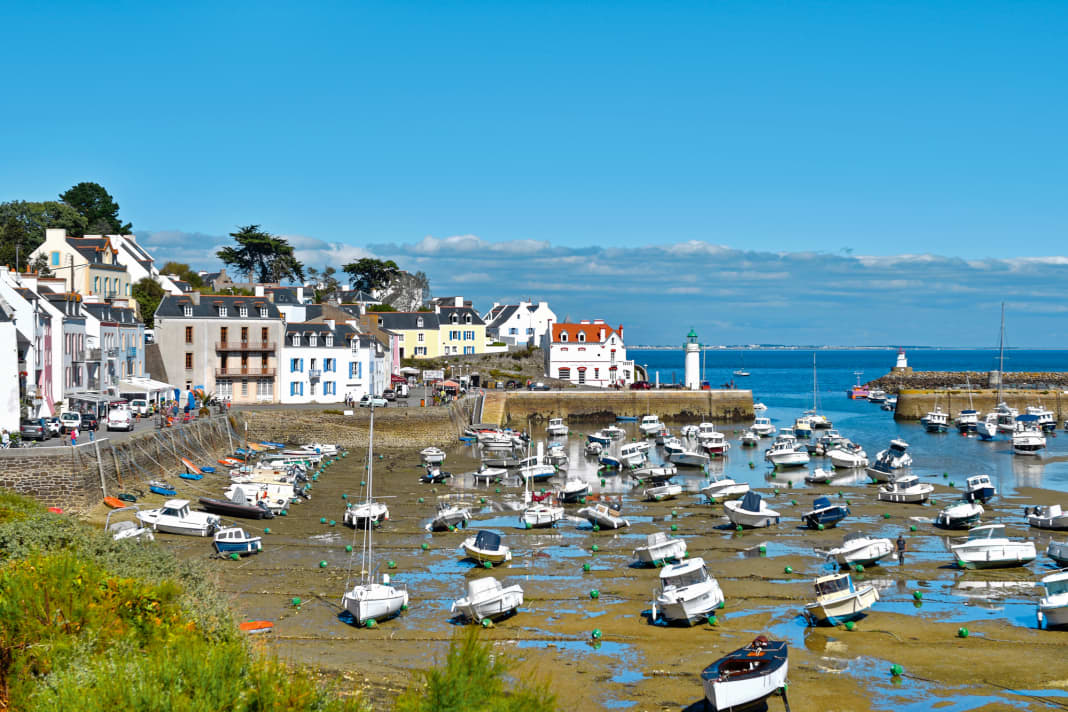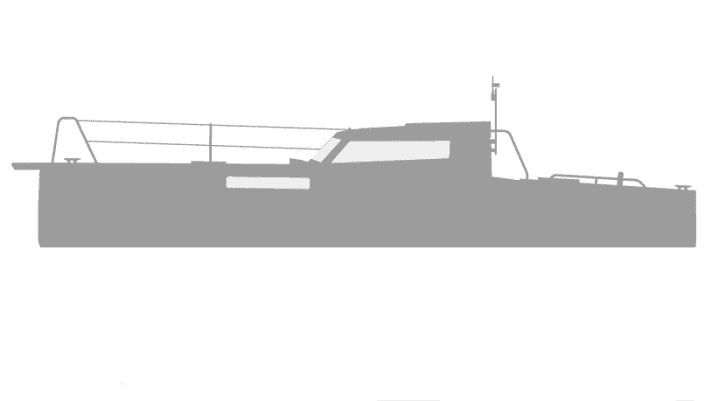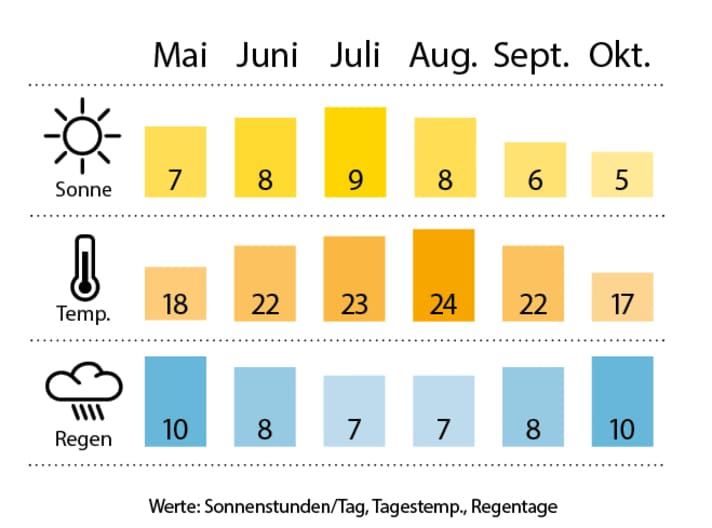





The bad news first: Asterix, the little Gaul who loves beating up Roman soldiers, is no longer a PR ambassador for Brittany. His job has been taken over by a certain Inspector Dupin. This fictitious lawman, created by a German crime writer, not only solves mysterious murder cases, he also familiarises his readers with the tourist highlights of Brittany. Since then, around 50 per cent more Germans have travelled to the region in the west of France. And yet the Mor-Bihan, the "little sea", as the Bretons call the 120 square kilometre lagoon-like body of water that flows into the Bay of Quiberon in the south of Brittany, is still something of a mare incognitum, at least for German leisure skippers, even in the eighth year of Monsieur le Commissaire.
François glances at his watch. "Monsieurs," he urges, "the Pont de Kérino bridge closes in half an hour. So let's go! Allez! Allez! Otherwise we'll be stuck in the harbour until the next high tide." We don't need to be told twice. In record time, the breakfast plates in the Breizh Café above the harbour master's office of the Port de Plaisance in Vannes are emptied, the lines of our Loxo 32 are untied and we are on our way to the mouth of the Marle into the Gulf.
Two or three sailing yachts come towards us on the dead-straight river, then the towers and fortress walls of the former duke's town recede behind us. The Maison Rose comes into view on the port side. This building, which is listed as a landmark on all nautical charts because of its pink façade, is one of the most photographed objects in the Gulf. I reach for my camera as the skipper of the bowrider in front of us puts the lever on the table - and literally blurs my subject. François just shakes his head.
Mor-Bihan, "little sea", as the Bretons call this body of water in the south of Brittany
The first destination of our five-day Gulf cruise is Île-d'Arz. We follow the shoreline of the flat, hook-shaped islet, head for the Plage de Pen Raz in the south-east and ... look for the jetty. But there isn't one. Instead, there are a few dozen mooring buoys bobbing in the waves a good 50 metres from the shore. As we don't have a dinghy on board, François grabs his mobile phone and calls the nearby Le Gléans sailing school.
It doesn't take long before a rubber dinghy picks us up and we stroll across a 3.1 square kilometre "mini" island that is as good as untouched by the hustle and bustle of modern mass tourism. After visiting the historic tidal mill in the south and the even older menhirs in the north, it's time for a second breakfast. The best galettes on the Île d'Arz are served at Crêperie Les Îles. Baked from beech wheat, these crêpes with savoury or sweet fillings are the manna of Brittany. They are served with cider. It is made from hand-picked Breton apples that are fermented in barrels in the traditional way.
Legend has it that there are as many islands in the Gulf of Morbihan as there are days in a year. This is, of course, a gross exaggeration. In reality, there are around 40, the exact number depending on the water level of the tides. The largest is Île-aux-Moines, which is around six kilometres long - and an absolute tourist magnet thanks to its picture-perfect natural beauty, flowering gardens, old captain's villas and views of the deep blue Gulf. The density of bars and bistros around the marina is correspondingly high. If it gets too crowded, a hire bike will help.
The stuff that "Asterix" is made of
Just a few minutes and the scent of orange and lemon trees is wafting around your nose on the way to the beaches. Open your history book: Anyone who was allowed to read Caesar's "Gallic War" in Latin class will know that the Roman general actually had considerable problems subjugating the local Celtic tribes in this corner of Gaul. Although his galleys were able to sink the Venetian fleet in the Bay of Quiberon in 56 BC, peace and order did not return.
A circumstance that would provide a certain René Goscinny with the material for his Asterix adventures two millennia later. While the little comic hero primarily beat up legionnaires, his companion Obelix also hewed menhirs on the side. These blocks, up to 20 metres high and weighing 350 tonnes, can still be found here today like sand by the sea. The reader is not told what function these menhirs had back then, whether they were landmarks, gravestones, meeting places or cult symbols. At the gates of the small town of Carnac, as many as 3,500 of these enigmatic stones wait in long rows for eternity.
There is supposed to be an island for every day of the year on Mor-Bihan. But there aren't quite so many after all
Perhaps the most spectacular prehistoric stone structure in Brittany, however, awaits us on the Île de Gavrinis, which lies just north of the mouth of the Gulf of Quiberon. 1500 years before the first pyramid was built in Egypt, industrious hands piled up a 50-metre quarry stone mound here, sealed it off at the top with a 17-tonne stone and decorated the inside with wave-shaped engravings. Incidentally, the tidal currents that wash around the island today at up to nine knots were not a problem back then: the "small sea" did not yet exist in this form. The stone colossi "only" had to be pulled over land for construction ...
The Stone Age is followed by the Middle Ages
Then it's up the river Auray. "After the Stone Age," smiles François, "comes the Middle Ages." We follow the picturesque bends at five knots and reach Saint-Goustan after seven nautical miles, where we moor our rhumb line at Quai Benjamin Franklin. Saint-Goustan is the harbour district of Auray. The small town of 13,000 people sits enthroned high above the right bank of the river. As Saint-Goustan can be accessed directly from the Atlantic at high tide, trade in wine, grain and salt from the Guérande salt works boomed in the Middle Ages. Auray was one of the richest towns in the region and Saint-Goustan was even the third largest harbour in Brittany. We stroll through the historic upper town, stroll along the flower-decorated half-timbered streets of the harbour district and four hours later are back in front of our semi-glider full of new impressions.
"If you're sailing in the Gulf without a tide table, you're in a bad position," says our skipper, pointing to the fact that the water level on the river has risen by two and a half metres in the meantime. However, we also have a good chance in La Trinité-sur-Mer: this Mecca of the French offshore sailing elite not only has a berth for us, but also a free (!) table in the restaurant Le Quai. We order Kir de Bretagne - cider with crème de cassis - as an aperitif and Ailes de Raie, skate wings in caper sauce with potatoes and vegetables, as our main course. Our appreciation of Breton cuisine is well received by the neighbouring tables. It doesn't take long before the first, second and next bottle of cider makes the rounds.
The Mor-Bihan flows into the Bay of Quiberon and thus into the Bay of Biscay
Santé! Cheers! To the Gulf of Morbihan! To the shipyard that built our Loxo 32! To Commissaire Dupin! And to Éric Tabarly, of course! This Breton veteran of a full-blooded sailor had won the English single-handed transatlantic regatta OSTAR twice. And thus showed the sailing world that the British can be beaten ... something the French Admiralty had not managed to do for 800 years in the dispute over naval supremacy between France and England.
The rest of the trip is quickly told: After a brief visit to the menhir in Carnac, we sail at 15 knots along the long, narrow Quiberon peninsula to Belle-Île. The name of the 87-square-kilometre island at the gates of the "little sea" says it all. In addition to the cliffs that Claude Monet made world-famous with his paintings, the "beautiful island" is known for its beaches, densely wooded valleys and quiet anchorages. The climate is Mediterranean and prices are around 30 per cent higher than on the mainland. In the high season, the harbour of the 2,500-strong capital Le Palais becomes a catwalk for the rich and famous from Paris. In September, the invasion of sandals and summer dresses from Chanel, Hermès & Co. bids farewell back to the capital.
Then the cloak of tranquillity once again covers the Île. Things are even more tranquil - even in August - on the neighbouring islands of Île-d'Houat and Île-d'Hoëdic. Here you can let Neptune be a good man, drop anchor and make yourself comfortable on deck with a book. Suitable literature would be "Asterix on a Grand Voyage" or Inspector Dupin's "Breton Surf". The order? Peu important... Never mind!
Service

Cruise stages
S Vannes (Port de Plaisance) - Île-d'Arz (Plage de Pen Raz): 6 nm
- Île-d'Arz (Plage de Pen Raz) - Île-aux-Moines (Port Miquel): 3 nm
- Île-aux-Moines (Port Miquel) - Île de Gavrinis (ferry terminal): 4 nm
- Île de Gavrinis (ferry pier) - Auray (Saint-Goustan): 7 nm
- Auray (Saint-Goustan) - La Trinité-sur-Mer: 12 nm
- La Trinité-sur-Mer - Belle-Île (Le Palais): 18 nm
- Belle-Île (Le Palais) - Île-d'Houat: 9 nm
- Île-d'Houat - Île-d'Hoëdic: 5 nm
- Île-d'Hoëdic - Vannes: 23 nm
Z Vannes
Total distance:87 nm
Literature
Cruising guide "South Brittany. French Atlantic coast from Le Guilvinec to La Rochelle" by Ralf Paschold. The 259-page guide includes 36 harbours and numerous anchorages. Paperback format, 2nd edition 2017; €34.90. www.hansenautic.de
Sport boat charts "NV-Atlas France FR6: South Brittany from Lorient à Île de Noirmoutier". NV-Verlag, A3 format, stapled, 2 over-sailors, 13 area charts, 20 detailed plans, navigation instructions in French and English, edition 2018; €49.00. www.nvcharts.com
The TOP 3 in the district
- Nantes According to "Time Magazine", the historic capital of Brittany on the lower reaches of the Loire is Europe's most liveable city ( www.nantes-tourisme.com ).
- Carnac Around the small town, 3,500 menhirs, which have been declared a World Heritage Site, invite you to visit them. The two kilometre long beach ( www.ot-carnac.fr ).
- Île d'Houat Hustle and bustle is a foreign word on this unspoilt fishing island and only appears, if at all, in the island thriller "The Portrait" by author Iain Pears.

OUR BOAT: Pogo Loxo 32 (GRP semi-planing) - length: 9.50 m - width: 2.55 m - draught: 0.7 m - cruising speed: 11 kn, maximum speed: 17 kn (factory specification) - engine: 75 hp (diesel) - equipment: plotter, inside and outside steering position, 1 double berth, 2 benches that can be converted into single beds. Kitchenette, WC/shower. The boat has also been available with electric drive since 2019. www.pogostructures.com
CHARTER: In Brittany (Loxo 32): www.bodivit.fr/location-bateau-loxo-32 (from 960 €/weekend) and www.samboat.de/boot-mieten/benodet/motorboot/46919 (from € 440/day). On the Gulf of Morbihan (other boat types, providers, etc.): www.nautal.fr/location-bateau-moteur-morbihan and www.atlantique-location.fr/location-bateau-moteur-morbihan
Weather/climate

Nautical information
THE REVIER The Gulf of Morbihan is a 120 square kilometre inland sea located roughly halfway between Brest in the north and La Rochelle in the south. Vannes, the capital of the department of the same name with a population of 52,000, lies around two kilometres inland and can be reached via the River Marle. The gulf itself is up to eleven nautical miles long, up to eight nautical miles wide and a maximum depth of 20 metres. Around a third of the water is mudflats. The passage between the Gulf and the Bay of Quiberon, and therefore the Atlantic, is almost 900 metres wide. Even though the tidal range is much more moderate at five metres compared to the Bay of Saint-Malo in the north of Brittany, the tidal current reaches speeds of up to 9 kn/h due to this "bottleneck". Thanks to the relatively small water surface, hardly any large waves are to be expected even at higher wind speeds.
However, this only applies to a limited extent to the Bay of Quiberon and of course not to the Atlantic-facing sides of the Quiberon peninsula and the island of Belle-Île. In the "small sea" it is not permitted to sail faster than 10 knots per hour and at distances of less than 300 metres from the shore no faster than 5 knots per hour. Sailing is prohibited at night. The infrastructure in the Gulf and on the offshore islands is good. In and around the Gulf there are over 30 Ports de Plaisance, pleasure boat marinas (overview: www.morbihan-tourismus.de/startseite/meerseite/freude-am-segeln/jachthafen ), with the Compagnie des Ports du Morbian being the top dog with 16 marinas and almost 11,000 berths ( www.compagniedesportsdumorbihan.com ).
DRIVER'S CERTIFICATE The prerequisite for hiring and operating charter boats is an official recreational craft licence.

